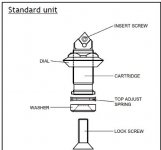Bill D
Diamond
- Joined
- Apr 1, 2004
- Location
- Modesto, CA USA
With the home made boring bar a cross hole is made to take a round or square tool that does the actual cutting. One end is drilled at 90 degrees the other at 45 degrees. The 90 degree allows cutting of groves and such work. The 45 end allows undercutting and bottom cutting..
But why is it 45 degrees? I read one guy who makes his at 60 degrees claiming it holds the tool with more support.
Is 45 chosen simply because it is half of 90 or is there some logic? I do understand the physics of thread angles being around 27.5 degrees for more strength.
Bill D
But why is it 45 degrees? I read one guy who makes his at 60 degrees claiming it holds the tool with more support.
Is 45 chosen simply because it is half of 90 or is there some logic? I do understand the physics of thread angles being around 27.5 degrees for more strength.
Bill D



